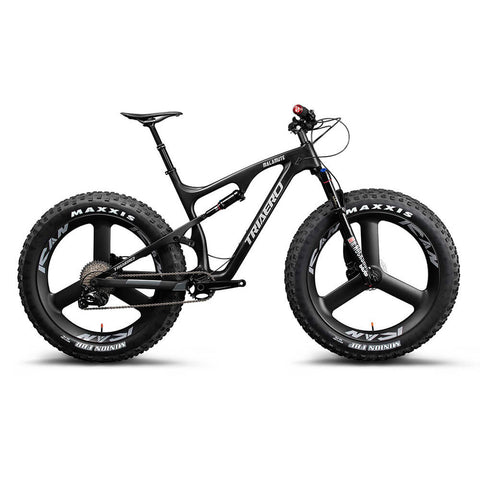What Is Fat Biking?
Fat biking sounds funny when you hear it, but it's not as strange. It has been around for a while and is becoming a trend for some of the edge it has over conventional bikes or mountain bikes. Fat bikes are basically bikes with fat tires— these tires usually have around three and a half inches to five inches. Compared to mountain bike tires that have widths not more than two and a half inches. Aside from the tires, they share some other differences with regular mountain bikes.
Fat bikes and mountain bikes have similar designs, but you can still tell the difference. Fat bikes are equipped with a larger tire and a thicker frame. Suspension forks in mountain bikes help the user ride through rough terrains while absorbing the shock and tension.
The tires on fat bikes are built to withstand this; they are not filled up to the same pressure as mountain bike tires. The breathing space in the tires makes it easy for the rider to have comfortable rides through rough terrains and maintain decent suspension levels. You can easily ride on mud or snow without the bike sliding or any other discomfort. It's mostly preferred for that reason. Fat bikes look funny. The design would fit as a meme or mockery of different bikes, but here we are today. They are one of the things people are freaked about.
What Are The Advantages Of Fat Bikes?
Fat bikes are pretty famous for their advantages over other bikes, and these advantages have contributed so much to their popularity in the past few years.
- Versatility
The primary advantage of fat bikes is their durability and ability to travel in every terrain, even in difficult ones. When it comes to handling different terrains, fat bikes never disappoint. Through rough roads and snow, they can handle mud, sand, and bumpy patches easily.
- Comfortability
If you're particular about not compromising your comfort while riding a bike, fat bikes will do the trick. The wild tires are built to provide a firmer grip and traction, absorbing almost every bump on the road, giving you a smooth ride all through.
- Improves your biking skills
Fat bikes can also help improve your biking skills, primarily since they work well on rough terrains. With time, you'll find that you can pedal over rough roads with more ease than usual.
How Fat Tires Work
The most significant noticeable difference between fat bikes and regular bikes is the difference in the size of tires. Fat bike tires are designed to give you a mega grip, so when you ride on snow and sand, they will not sink in as regular tires would. Fat bike tires are between 4 and 5 inches, compared to standard tires with only 2.4 inches in width. Their wheels also have a 26 inches width; this massive volume gives them the riding characteristics they possess.
Rock shocks make the Bluto suspension much wider, making enough space for the tire. The hubs are more expansive, the bottom brackets are wider, and the rear hub is wide enough to fit the tire into the frame. The front hub width on the rock shock is around 150 millimeters compared to the 100 millimeters you would get on regular bikes, and the rims are much wider. These features combined make the fat tires work the way they do, making it possible to travel quickly over diverse terrains.
Comparing Fat Bikes to Other Bikes
Before you make your purchasing decision, what are the real differences between fat bikes and some other bikes? Although we have earlier established that the significant thing differentiating fat bikes from other bikes is the size of their tires, you still need to get a clear idea of what these variations are. To know which one is best for you, you have to know the essential components of both categories of bikes.
Durability
When it comes to comparing the durability of the fat bike and other bikes, fat bikes win every time. Fat bikes have sportier and heavier builds in comparison to the lightweight of different bikes. They are mostly built to withstand harsh terrains and rocky patches better.
Traction
Fat bikes have better traction when compared to other bikes. This is mainly due to the low-pressure tires, which allow a firmer grip on terrains. The pressure prevents premature wear to their tires, making them last for an extended period. Most typical far tires have a pressure range of about 20 psi. Although sometimes, they can go as low as 10 to 13 psi, making them much lower than the 32 to 40 psi of normal tires.
Wheels
The larger volume on the wheels of fat bikes makes it easier to move on rough patches. Regular bikes have smaller wheels and are less versatile when it comes to moving on different terrain. Additionally, some fat bikes are designed to accommodate both the fat tire rims and also regular tire rims, meaning you can change from one to the other subsequently.
What Type of Rider is Suitable For Riding a Fat Bike
Fat bikes are not only known for their capacity to fare well on off-road terrains, but they are also great and best for overweight cyclists. Their wider tires and sturdy builds are the best for withstanding extra weight. However, they are not mainly built for heavy riders; they only offer better traction to withstand such pressure better.
Conclusion
The whole point of this article is to help you understand the significant components of fat bikes and why they can be of advantage to you. However, before I leave you to start making your purchase decisions, let me share one last important tip. The type of bicycles you choose to use depends on the kind of terrain they will use. While fat bikes perform well in off-road terrains, other bikes might be best for you if you want to traverse regular terrains.

